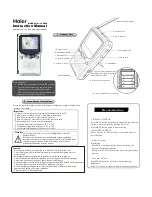
SS-OCT System Base Unit
Chapter 4: System Operation
Rev A, December 17, 2018
Page 31
4.3. Advanced Adjustments
4.3.1. Focus and Choice of Objective Lens
In OCT, an objective lens is used to focus the light beam on and into the sample and also to collect the
backscattered light. The focused nature of the beam means that the lateral extension of the beam is different
along the depth axis. Since OCT records signals along this depth axis, the collected signal corresponds to
different lateral extensions of the beam and therefore the resolution is different along the depth axis. The best
resolution can be obtained from the axial focus plane; the further away from the focal plane the light is
backscattered from, the more blurred out the signal will appear.
The length of the axial focus depends on the optics of the OCT system, especially on the choice of the objective
lens. For samples with a small axial focus length, an objective lens with a high numerical aperture can be
chosen. This will grant a small lateral and axial focus, hence allowing a more in-depth analysis of the sample
but also restricting the axial depth that can be investigated. For samples with a deep region of interest it is
helpful to choose an objective with a low numerical aperture, thus being able to collect signals from a large
focus band. However, low numerical aperture objective lenses will decrease the lateral resolution of the image.
Figure 39
OCT B-Scans of scattering particles taken with LSM02, LSM03, and LSM04
Thorlabs offers three objective lenses for different purposes. Figure 39 shows the difference in lateral resolution
and depth of focus for the LSM02 (high resolution imaging), LSM03 (general purpose), and LSM04 (high depth
of focus). Note the change in signal strength and lateral resolution over depth caused by an increasing focus
band.
Please contact Thorlabs for more information on how to incorporate different objective lenses in your OCT
system.
















































